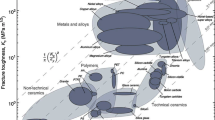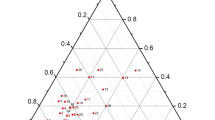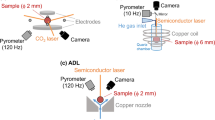Abstract
Fe–Cu alloys can be characterized as a system with immiscible components (IC). This statement is based on a weak mutual solubility in the solid state. In addition, Fe–Cu system stratifies in the liquid state at low carbon content. Alloys with ICs have a simple phase composition of almost pure components, which determines a significant practical interest in these alloys. Manufacturers have technologically succeeded in achieving dam** alloys of Fe–Cu–Pb system. With proper technological preparation, the final product can be obtained by combining the properties of pure alloy components in the fraction required for practical application. For example, diamagnetic copper has high electrical conductivity and thermal conductivity in Fe–Cu alloys, while ferromagnetic iron has enhanced strength characteristics compared to copper. When the alloy structure is organized in a certain way, a final product can be obtained with high electrical conductivity and thermal conductivity of copper, enhanced strength properties of iron, or a hard magnetic material with copper ductility. The studies of iron-copper alloys focused on the structural studies and measurements of service properties. At the same time, the dynamics of macro- and microstructure alloy formation were not analyzed. In the present studies, the macrostructure formation dynamics of the solid phase enriched with iron at the crystallization melt process during cooling was studied using high-temperature viscometry. Due to the effect of the melt-cooling rate on the size and morphology of crystallizing inclusions, as well as a significant amount of the two-phase area, special attention was paid to the thermophysical analysis of the measurement mode. Analysis of the reliability of the results obtained was made by the viscosity measurement method. The phase state of Fe–Cu system melts was investigated during cooling by changing the dam** factor. The analysis of thermophysical processes occurring during measuring the dam** factor was carried out. The measuring process of dam** decrement takes place under quasi-equilibrium conditions and the cooling rate is close to zero. There are no temperature gradients, both in radius and in height. For compositions Fe50Cu50, Fe40Cu60, and Fe30Cu70, the precipitation dynamics of the solid phase was determined.







Similar content being viewed by others
REFERENCES
Yang, X., Jiang, C., Zou, J., and Wang, X., Preparation and characterization of CuFe alloy ribbons, Rare Met. Mater. Eng., 2015, vol. 44, no 12, pp. 2949–2953.
Bachmaier, A., Kerber, M., Setman, D., and Pippan, R., The formation of supersaturated solid solutions in Fe–Cu alloys deformed by high-pressure torsion, Acta Mater., 2012, vol. 60, no 3, pp. 860–871.
Alami, A.H., Alketbi, A., and Almheiri, M., Synthesis and microstructural and optical characterization of Fe–Cu metastable alloys for enhanced solar thermal absorption, Energy Procedia, 2015, vol. 75, pp. 410–416.
Lucas, F.M., Trindade, B., Costa, B.F.O., and Le Caër, G., Mechanical alloying of Fe–Cu alloys from as-received and premilled elemental powder mixtures, Key Eng. Mater., 2002, vol. 230-232, pp. 631–634.
Alami, A.H., Zhang, D., Aoka, C., and Abed, J., Influence of magnetic field on the mesoporous structure of Fe–Cu compounds in dye-sensitized photovoltaic cells, Energy Procedia, 2016, vol. 65, pp. 389–398.
Barthem, V.M., Noce, R.D., Mocedo, W.A., and Givord, D., Magnetic properties of electrodeposited Fe-poor Fe–Cu alloys, Braz. J. Phys., 2009, vol. 39, no. 1, pp. 178–185.
Blackstok, J.J. and Ackland, G.J., Phase transitions of copper precipitates in Fe–Cu alloys, Philos. Mag. A, 2001, vol. 81, pp. 2127–2148.
Annamalai, R., Upadhyaya, A., and Agrawal, D., An investigation on microwave sintering of Fe, Fe–Cu and Fe–Cu–C alloys, Bull. Mater. Sci., 2013, vol. 36, no. 3, pp. 447–456.
Liu, J.Z., van de Walle, A., Ghosh, G., and Asta, M., Structure, energetics, and mechanical stability of Fe–Cu BCC alloys from first-principles calculations, Phys. Rev. B, 2005, vol. 72, no. 14, pp. 144109.
Noce, R.D., Gomes, O.D.M., de Magalhães, S.D., Wolf, W., et al., Magnetic properties of Fe–Cu alloys prepared by pulsed electrodeposition, J. Appl. Phys., 2009, vol. 106, no. 9, p. 093907.
Mashimo, T., Huang, X., Fan, X., Koyama, K., and Motokawa, M., Slater-Pauling curve of Fe–Cu solid solution alloys, Phys. Rev. B, 2002, vol. 66, no. 13, p. 132407.
Ursev, V.N., Mirzaev, D.A., and Yakovleva, I.L., Transformation of austenite in Fe–Cu alloys. I: Kinetics of the transformation, Phys. Met. Metallogr., 2008, vol. 105, no 3, pp. 298–304.
Avraamov, Yu.S. and Shlyapin, A.D., Novye kompozitsionnye materialy na osnove nesmeshivayushchikhsya komponentov: poluchenie, struktura, svoistva (New Composite Materials Based on Immiscible Components: Production, Structure, and Properties), Moscow: Mosk. Gos. Ind. Univ., 1999.
Nayan, N., Narayana Murty, S.V.S., Jha, A.K., Pant, B., Sharma, S.C., George, K.M., and Sastry, G.V.S., Processing and characterization of Al–Cu–Li alloy AA2195 undergoing scale up production through the vacuum induction melting technique, Mater. Sci. Eng., A, 2013, vol. 576, pp. 21–28.
Mittler, T., Greß, T., Feistle, M., Krinninger, M., Hofmann, U., Riedle, J., Golle, R., and Volk, W., Fabrication and processing of metallurgically bonded copper bimetal sheets, J. Mater. Process. Technol., 2019, vol. 263, pp. 33–41.
Sanin, V.V., Anikin, Yu.A., Yukhvid, V.I., and Filonov, M.R., Structural heredity of alloys produced by centrifugal SHS: influence of remelting temperature, Int. J. Self-Propag. High-Temp. Synth., 2015, vol. 24, no. 4, pp. 210–214.
Sanin, V.V., Filonov, M. R., Yukhvid, V.I. and Anikin, Y.A., Structural investigation of 70Cu/30Fe based cast alloy obtained by combined use of centrifugal casting-SHS process and forging, MATEC Web Conf., 2017, vol. 129, pp. 1–4.
Lykov, A.V., Teoriya teploprovodnosti (Theory of Heat Conduction), Moscow: Vysshaya shkola, 1966, 597 p. (In Russ.).
Filonov, M.R., Anikin, Yu.A., and Levin, Yu.B., Teoreticheskie osnovy proizvodstva amorfnykh i nanokristallicheskikh splavov metodom sverkhbystroi zakalki (Theoretical Basis for the Production of Amorphous and Nanocrystalline Alloys by Ultrafast Quenching), Moscow: Mosk. Inst. Stali Splavov, 2006.
Shvidkovskii, E.G., Nekotorye voprosy vyazkosti rasplavlennykh metallov (Viscosity of Molten Metals), Moscow: Gostekhizdat, 1955.
Funding
This work was supported by the Ministry of Education and Science no. 11.1397.2017/PCh.
Author information
Authors and Affiliations
Corresponding authors
Additional information
Translated by A. Bannov
About this article
Cite this article
Filonov, M.R., Sanin, V.V., Anikin, Y.A. et al. Investigation of Two-Phase State of Fe–Cu Melts during Cooling in a Viscometer. Steel Transl. 49, 732–737 (2019). https://doi.org/10.3103/S0967091219110032
Received:
Revised:
Accepted:
Published:
Issue Date:
DOI: https://doi.org/10.3103/S0967091219110032




